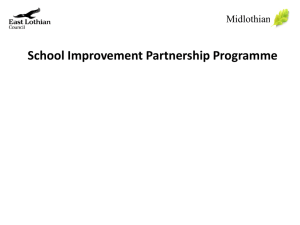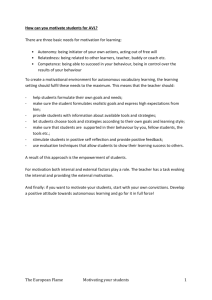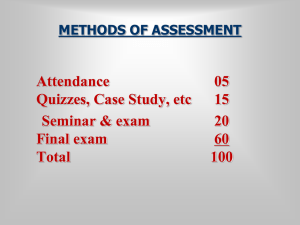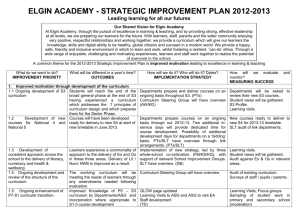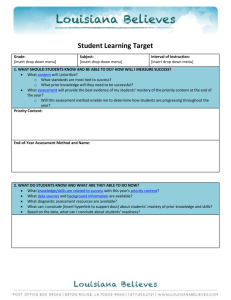Goals & Goal Orientation
advertisement
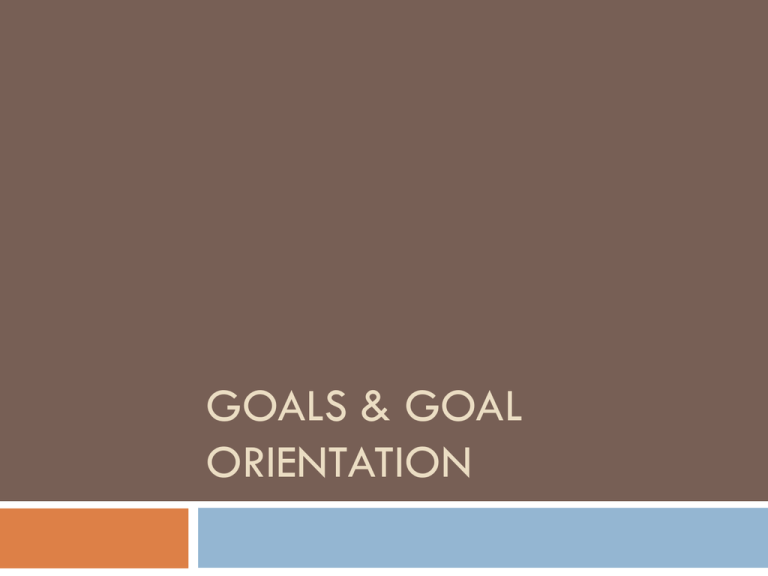
GOALS & GOAL ORIENTATION Needs Drive Human Behavior Murray Maslow Importance of goals & goal setting on motivation Goal setting is a key motivational process. Learners with a goal and a sense of self-efficacy for attaining it engage in activities they believe will lead to goal attainment. Goal attainment can lead learners to adopt new goals. Goals that are proximal, specific, and moderately difficult offer the greatest motivational benefits. Motivation is enhanced when learners are enthusiastic about the goal and are determined to attain it. Self-set goals often motivate better than assigned goals. Goals that are imposed may not motivate if people believe they are too far beyond their skill levels. It is critical that learners believe that with reasonable effort and persistence they can attain their goals. Group goals can enhance motivation when group members accept the goal – when members support the goal and each member has some responsibility for goal attainment. Motivation = Goals X Emotions X Personal Agency Beliefs Goal content Refers to the desired or undesired consequences of a particular goal. Could be assessed by asking people what they want, what they are trying to accomplish, and why they did something. Intrapersonal Goals/Desired-Within-Person Consequences Affective goals Cognitive goals Subjective Organization goals Interactional Goals/Desired-Person-Environment Consequences Self-assertive social relationship goals Integrative social relationship goals Task goals Applying Goal Content Theory in the Classroom Help students activate a relevant goal for completing a task. Ensure that goals that are activated are clear, compelling, and presented in such a way that students understand what they need to do to accomplish them. Help students activate multiple goals. Create appropriate emotions that facilitate motivation. Goal Orientation Theory The purposes or reasons for engaging in achievement behaviors. An integrated pattern of beliefs that lead to different ways of approaching, engaging in, and responding to achievement situations. Reasons why we pursue achievement tasks, not just the performance objectives. A type of standard by which individuals judge their performance and success or failure in reaching the goal. Mastery Goal-Orientation A focus on learning, mastering the task according to self-set standards or self improvement, developing new skills, improving or developing competence, trying to accomplish something challenging, and trying to gain understanding or insight. Affect, cognitive, and behavior outcomes Performance Goal Orientation Represents a focus on demonstrating competence or ability and how ability will be judged relative to others; for example, trying to surpass normative performance standards, attempting to best others, using social comparative standards, striving to be the best in the group or class on a task, avoiding judgments of low ability or appearing stupid, and seeking public recognition of high performance levels. Affect, cognitive, and behavior outcomes Approach/Avoidance Orientations Approach-Mastery Orientation Avoidance-Mastery Orientation Approach-Performance Orientation Avoidance-Performance Orientation Applying Goal Orientation Theory in the Classroom TARGET: task, authority, recognition, grouping, evaluation, and time Focus on meaningful aspects of learning activities. Design tasks for novelty, variety, diversity, and interest. Design tasks that are challenging, but reasonable in terms of students’ capabilities. Provide opportunities for students to have some choice and control over the activities in the classroom. Focus on individual improvement, learning, progress, and mastery. Strive to make evaluation private, not public. Recognize student effort. Help students see mistakes as opportunities for learning. Use heterogeneous cooperative groups to foster peer interaction; use individual work to convey progress. Adjust time on task requirements for students having trouble completing work; allow students to plan work schedules and time lines for progress.






